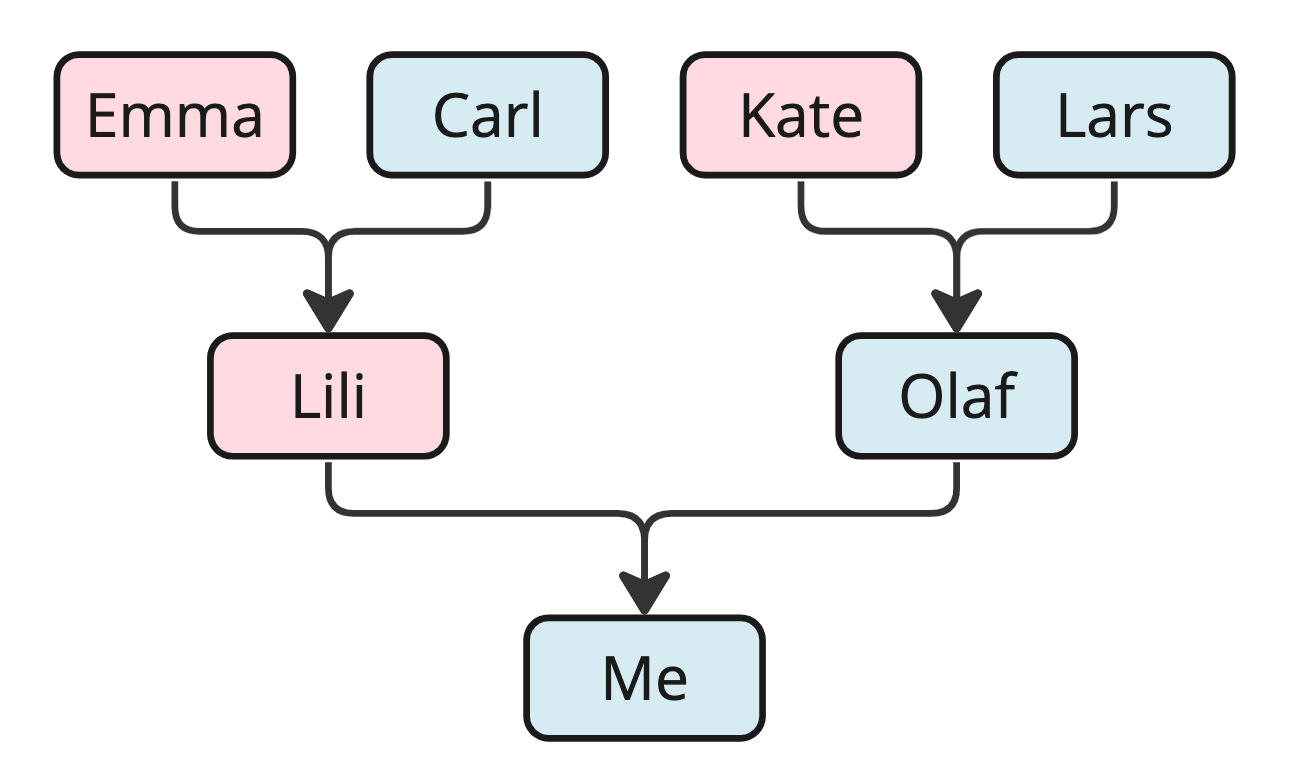
Data Structures is about how data can be stored in different structures.
Algorithms is about how to solve different problems, often by searching through and manipulating data structures.
Theory about Data Structures and Algorithms (DSA) helps us to use large amounts of data to solve problems efficiently.
A data structure is a way to store data.
We structure data in different ways depending on what data we have, and what we want to do with it.

First, let's consider an example without computers in mind, just to get the idea.
If we want to store data about people we are related to, we use a family tree as the data structure. We choose a family tree as the data structure because we have information about people we are related to and how they are related, and we want an overview so that we can easily find a specific family member, several generations back.
With such a family tree data structure visually in front of you, it is easy to see, for example, who my mother's mother is—it is 'Emma,' right? But without the links from child to parents that this data structure provides, it would be difficult to determine how the individuals are related.
Data structures give us the possibility to manage large amounts of data efficiently for uses such as large databases and internet indexing services.
Data structures are essential ingredients in creating fast and powerful algorithms. They help in managing and organizing data, reduce complexity, and increase efficiency.
In Computer Science there are two different kinds of data structures.
Primitive Data Structures are basic data structures provided by programming languages to represent single values, such as integers, floating-point numbers, characters, and booleans.
Abstract Data Structures are higher-level data structures that are built using primitive data types and provide more complex and specialized operations. Some common examples of abstract data structures include arrays, linked lists, stacks, queues, trees, and graphs.
An algorithm is a set of step-by-step instructions to solve a given problem or achieve a specific goal.

A cooking recipe written on a piece of paper is an example of an algorithm, where the goal is to make a certain dinner. The steps needed to make a specific dinner are described exactly.
When we talk about algorithms in Computer Science, the step-by-step instructions are written in a programming language, and instead of food ingredients, an algorithm uses data structures.
Algorithms are fundamental to computer programming as they provide step-by-step instructions for executing tasks. An efficient algorithm can help us to find the solution we are looking for, and to transform a slow program into a faster one.
By studying algorithms, developers can write better programs.
The algorithms we will look at in this tutorial are designed to solve specific problems, and are often made to work on specific data structures. For example, the 'Bubble Sort' algorithm is designed to sort values, and is made to work on arrays.
Data structures and algorithms (DSA) go hand in hand. A data structure is not worth much if you cannot search through it or manipulate it efficiently using algorithms, and the algorithms in this tutorial are not worth much without a data structure to work on.
DSA is about finding efficient ways to store and retrieve data, to perform operations on data, and to solve specific problems.
By understanding DSA, you can:
Data Structures and Algorithms (DSA) are used in virtually every software system, from operating systems to web applications:
DSA is fundamental in nearly every part of the software world:
As we go along in this tutorial, new theoretical concepts and terminology (new words) will be needed so that we can better understand the data structures and algorithms we will be working on.
These new words and concepts will be introduced and explained properly when they are needed, but here is a list of some key terms, just to get an overview of what is coming:
| Term | Description |
|---|---|
| Algorithm | A set of step-by-step instructions to solve a specific problem. |
| Data Structure | A way of organizing data so it can be used efficiently. Common data structures include arrays, linked lists, and binary trees. |
| Time Complexity | A measure of the amount of time an algorithm takes to run, depending on the amount of data the algorithm is working on. |
| Space Complexity | A measure of the amount of memory an algorithm uses, depending on the amount of data the algorithm is working on. |
| Big O Notation | A mathematical notation that describes the limiting behavior of a function when the argument tends towards a particular value or infinity. Used in this tutorial to describe the time complexity of an algorithm. |
| Recursion | A programming technique where a function calls itself. |
| Divide and Conquer | A method of solving complex problems by breaking them into smaller, more manageable sub-problems, solving the sub-problems, and combining the solutions. Recursion is often used when using this method in an algorithm. |
| Brute Force | A simple and straight forward way an algorithm can work by simply trying all possible solutions and then choosing the best one. |
In this tutorial, you will first learn about a data structure with matching algorithms, before moving on to the next data structure.
Further into the tutorial the concepts become more complex, and it is therefore a good idea to learn DSA by doing the tutorial step-by-step from the start.
And as mentioned on the previous page, you should be comfortable in at least one of the most common programming languages, like for example JavaScript, C or Python, before doing this tutorial.
On the next page we will look at two different algorithms that prints out the first 100 Fibonacci numbers using only primitive data structures (two integer variables). One algorithm uses a loop, and one algorithm uses something called recursion.
Click the 'Next' button to continue.